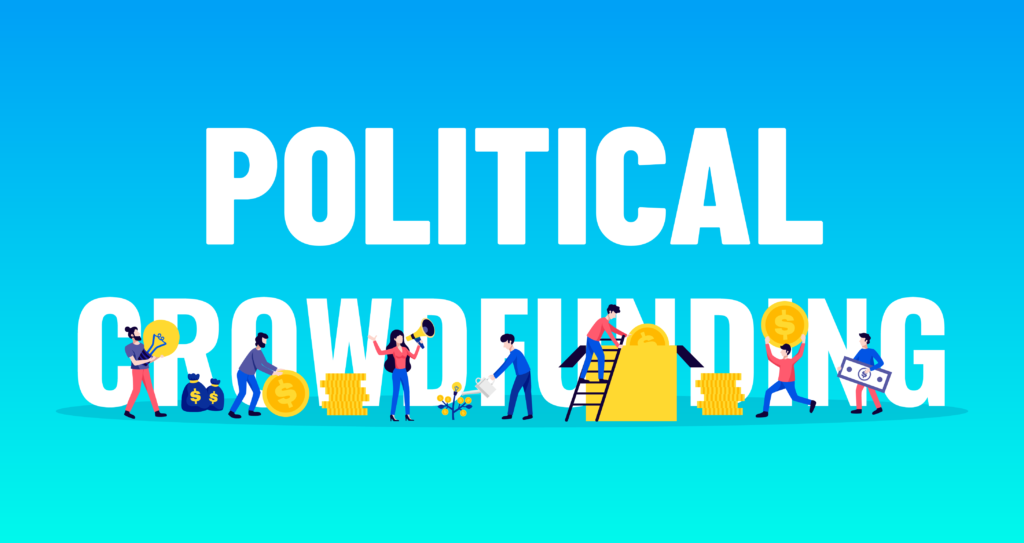
Political crowdfunding through online or digital means has gained traction in recent times. The agenda of crowdfunding has generating funds for various sectors such as healthcare, services, education, civic development, and donations for political party candidates. This primer seeks to explore the rationale behind online crowdfunding, examining crowdfunding from a holistic perspective — it attempts to understand various arenas of crowdfunding. Unpacking nuances of online crowdfunding means comprehending the prospects and concerns associated with the platform, the issues faced in ensuring a transparent transaction be it election related funding or crowdsourcing money for humanitarian cause. The primer endeavours to unveil various debates on intersection of online crowdfunding and transparency, accountability in a democracy.
Community as a key actor in Crowdfunding
The word ‘community’ here connotes group of people connected with each other through bonds of kinship such as caste, religion, class, caste and gender. While there are diversities and differences among people based on socio-economic factors, the larger political question for any party candidate is to target communities virtually. A political candidate may make use of grassroot campaigns to establish online social networks with these communities. These strategies not only bridges the gap between a political candidate and citizenry, but also organises them as communities. This doesn’t mean there will not be any difference of opinion amongst them, however, these differences will be targeted effectively to generate donations. Grassroots campaigns and social media campaign go hand in hand to raise money, share ideas and engage communities with the agenda of a political candidate.
A study by Pew Research Foundation has shown that during Barack Obama’s campaign all adults used sms technology to seek donations for his program. This technology gained immense popularity among African-American and Latino voters since both of these blocks are democrats and are considered to be Obama friendly vote bank. The use of crowdfunding across different subcultures rather than sending generic emails to target mass citizenry has garnered support and funds. To mention examples of such campaign: Sandra Fluke, a well-known feminist and advocate for gay rights sends emails discussing contraception, rape and health choices to Obama’s email base. The issue-centric politics is a critical point for female voters to donate and show support for Obama’s political narrative.
While issue-centric politics along with grassroots campaigns and targeting subculture is one way to generate political funding, other ways are that of seeking small donations rather than enmassing funds from investors and capitalists. This is the larger rationale behind crowdfunding and generating funds subjected to public scrutiny. Crowdfunding during Obama’s campaign relied amply on contributions from friends, family and virtual communities rather than hedge funds and angel investors. Small donors are necessary not only in terms of material support but also in contributing towards the campaign as volunteers. These volunteers often make phone calls, hand out literature and pamphlets. Small donors are also lured into the online crowdfunding by attaching big rewards or perks such as dinners or meetups with celebrities. These campaigns were popularised as dinner with George Clooney, dinner with Two Presidents, Obama Classic etc.
We have seen above how online crowdfunding transitions from solely being a money-making exercise to a strategic engagement between political community and citizenry. Nevertheless, a flipside associated with political crowdfunding is that of political inequality. This becomes clear if we look at the case Collin’s vote for Bret Kavanaugh’s Supreme Court nomination.
Bret Kavanaugh’s nomination for Supreme Court – Crowdpac accused of ‘bribery’
enator Susan Collins vote for Bret Kavanaugh in 2018 for Supreme Court has crowdfunded $ 3 million for her Democratic opponent in 2020. As this Vox report says, “Hosted on the crowdfunding site Crowdpac, the campaign experienced such an influx of donors as Collins spoke about her decision to back Kavanaugh on the Senate floor”. Although Collins denounced this crowdfunding initiative as ‘quid pro quo funding’, dubbing it as bribery, she also promised that she will not let money influence her decision. Nevertheless, her vote for nominating Kavanaugh not only raised a voice in support of anti-healthcare, anti-labour, anti-woman, and anti-environment agenda.
Her vote sparked a debate between left wing and and conservatives. While left wing argued that Crowdpac’s funding initiative was nothing less than bribery, conservatives favored the campaign.
This incident of crowdfunding reflects a stark reality of crowdfunding and political inequalities in the using money for influence. Charlotte Hill argues that crowdfunding is marred by a political system where money operates in disproportionate manner. This money and influence is often controlled by privileged and elite class whose politics runs counter to that of progressives. In this manner, crowdfunding needs to be more accessible and create a level playing field for increasing the political power of poor and middle-class citizenry. This is the only way crowdfunding can become inclusive and ensure a just distribution of money for a political propaganda.
Transparency and Ideological Challenges
The rationale behind crowdfunding is that of subjecting electoral funds or any online crowdsourced initiatives to public gaze. The idea of citizen engagement with the online crowdfunding is not only to ensure a transparent governance but also inches towards equal and accessible democracy.
Anand Mangnale, Co-founder and Director of ourDemocracy.in, says, “Our company provides a platform for everyone to start the campaign so that people on all sides of the political spectrum — right or left should come ahead for funding their campaign”. When all the political inclinations are free to access a crowdfunding platform, it automatically brings accountability and accessibility into politics.
Discussing the politics of ‘ourdemocracy.in’, Mangnale says, “As a political platform we are neutral, working with political candidates and parties approved by the Election Commission”. In that sense OurDemocracy complies with the legal ground rules and also, adheres to two specific terms and conditions for every political candidate. Firstly, hate-mongers are barred and secondly, they shouldn’t have criminal case on violence against women.
Parties asking for money is based on the idea of party donations whereas crowdfunding politics revolves around the issue-centric politics. The promotion of campaign such as digital marketing, sending mass messages is also done through the accumulated money. Therefore, the funds collected are disbursed for promotion and other expenses in a transparent manner rather than doing a free service. The poll, volunteer and ground level expenses are met by the respective candidate once their campaign has been digitally marketed efficiently. Digital marketing of a campaign comprises of creating a network of messages, emails, and promotional strategies for a candidate rather than having a simple ‘donate’ button.
In terms of collection of funds for political campaign, the contributors are verified through a three-layered method. This involves email verIfication, one time password (OTP) verification, put address in the field and enclose a copy of pan-card. According to the Election Commission of India, every donation above Rs. 30,000 should have a pan card and address proof attached. However, for humanitarian campaigns like flood-relief campaign, the verification rules are considerably relaxed. This creates a transparent mechanism and encourages citizenry to engage with the campaign.
Yash Marwah, who has worked with various crowdfunding and pro-transparency initiatives argues that “political crowdfunding exposes unaccountable money that goes into elections”. However, crowdfunding is not enough, it is also enough for a certain kind of good politics to have social capital as well. In terms of ideological challenges and crony capitalism, political crowdfunding creates a platform for a candidate to have money that is accounted for, has an informed source and promotes transparent democracy. Nonetheless, the politics of crowdfunding also largely depends on the kind of politics they are supporting and advocating for. For example, a crowdfunding platform called ActBlue in USA supports a pro-democratic campaign— such platforms often set the tone for the kind of politics they will promote and advertise. However, for Kickstarter or other platforms funding a certain kind of money politics is often involved in funding a certain kind of political campaign.
Arenas of Crowdfunding- its prospects and concerns
Crowd Urbanism : A number of city projects are being funded by the citizens, thereby, contributing towards civic development. A magazine called Joseph Pulitzer organised mass crowdfunding for New York Statue of Liberty. The statue is partially a result of crowdfunding efforts. Similarly, in UK 45 local governments that is 10 percent of the total, crowdfund different local development programmes. Run by different organisations like SpaceHive in Brighton, projects have to reach a certain funding target to spend any of the pledges. Chris Gourlay, Founder and CEO of SpaceHive quoted in this report, “I was interested in creating a space to the side of what you would call the state’s core responsibilities, where there is an opportunity for collaboration and for people to do things over and above what they might expect their tax dollars to go on.”
Civic crowdfunding has emerged as an alternative when government’s funds are shrinking and challenges from investors are increasing. The crowdfunding space has allowed people to invest, help businesses and people alike to contribute money in the projects whose viability they can measure.
Wall Border campaign by GoFundMe: The concern about the refugee crisis in Europe and the rise of the far right forces has paved a way for right wing crowdfunding initiatives. A right-wing website in the USA raised a demand to fund a wall border campaign between Mexico and the US to put a halt on migration. The political campaign called ‘We The People Will Fund the Wall’ generated $ 13 million. The war veteran namely Brian Kolfage started the campaign quoted in the report, “As a veteran who has given so much, 3 limbs, I feel deeply invested in this nation to ensure future generations have everything we have today”. This kind of political crowdfunding campaign is bound to produce exclusion based politics and has been opposed by immigration advocacy groups.
Crowdfunding in Healthcare : A campaign in 2014 for Mike Brandon, a cancer patient in Bristol raised more than £450,000 for experimental therapy in the US and was appreciated as the most successful campaign in the UK. Similarly, in 2017, “nearly £1.4m was raised by the family of Charlie Gard, a boy born in August 2016 with a rare genetic disorder, whose case dominated the headlines for months”. These health campaigns often turn into a popularity contest — where people are marketing themselves and their health conditions to generate money. This also means projecting out one’s vulnerabilities on social media platforms which can generate a mixed response from the netizens.
This Guardian report has indicated, “Much of the time, crowdfunding doesn’t work: Kenworthy’s research (with her collaborator Lauren Berliner) shows that fewer than 10% of pages reach their financial targets. The people behind them tend to be highly literate, tech savvy and well connected in PR or media”. Furthermore, in the case of terminally ill patients, need of the hour is pain management, palliative care and spending valuable time with family. Therefore, in the case of healthcare, crowdfunding is an emerging popular market but it is essential to question the effectiveness of its methods for comforting patients.



